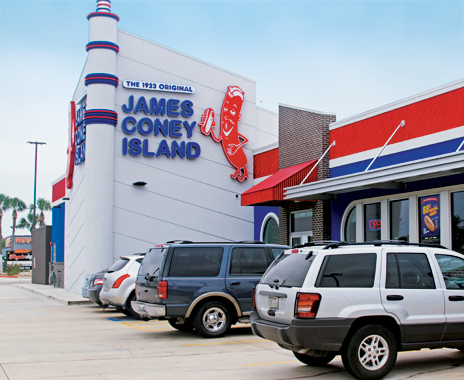Stop a local in the Chicago area, inquire about the closest Portillo’s restaurant, and you’re almost certain to get directions to the Chicago-based chain’s nearest location (alongside some ordering suggestions). With its signature Vienna beef hot dogs and Italian beef sandwiches, Portillo’s is a Windy City icon, a beloved local favorite that many current and ex-Chicagoans speak about with reverence for its quality food, efficient service, and lively atmosphere.
The farther away from Chicago, however, the less weight the Portillo’s name holds—the company has focused its expansion over the years almost entirely on the Chicago metro area, weaving itself into the fabric of the Second City.
Several other quick-serve concepts around the U.S. share a similar story: fame and fanaticism in one market, unfamiliarity in others. The strategy stands in stark contrast to the industry’s aggressive-development norm, one in which multiunit success comes from threading together several markets across the U.S. But a handful of companies have discovered that, with fervent followings and an identity rooted in their hometowns, it is possible to thrive among ever-increasing competition, a growing regulatory environment, and shifting consumer tastes.
Here, QSR profiles five regional concepts to find out how they stood the test of time and became an entrenched, celebrated player on their local food scene.
James Coney Island
Houston
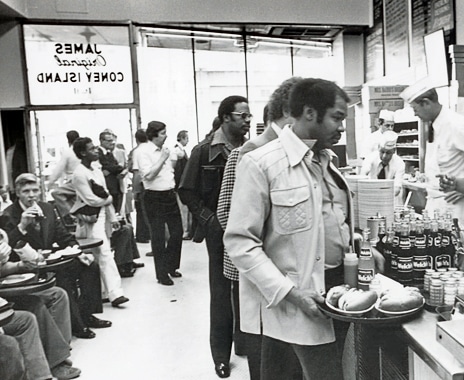 Since its 1923 founding by a pair of Greek brothers, James Coney Island has been a Houston staple. Its Frito pies and classic Coney—a signature wiener served on a hand-cut bun and topped with mustard, chili sauce, minced onion, and cheese—remain familiar comforts to local residents. Each day, James Coney Island sells about 20,000 Coney Dogs across its 21 Houston-area locations.
Since its 1923 founding by a pair of Greek brothers, James Coney Island has been a Houston staple. Its Frito pies and classic Coney—a signature wiener served on a hand-cut bun and topped with mustard, chili sauce, minced onion, and cheese—remain familiar comforts to local residents. Each day, James Coney Island sells about 20,000 Coney Dogs across its 21 Houston-area locations.
“We have a real story in this city spanning 90 years, and the pictures to prove it,” says Darrin Straughan, president of James Coney Island.
As much as that history is a beloved asset, Straughan says, the company’s past success does not cloud the concept’s future. Since becoming company president in 1994, Straughan, a native Houstonian, has worked to balance the chain’s rich history with its future prospects, closing outdated stores in favor of newer outlets that better reflect Houston’s demographic shifts and revamping the chain’s menu with the addition of Greek salads, Asian sandwiches, and turkey chili.
“Because of the competition and costs in today’s market, we can’t just sell hot dogs,” Straughan says. “Now, there’s no way we could—or would—ever get rid of our original Coney, but we also want to overcome any veto vote.”
As a reflection of the brand’s progressive vibe, James Coney Island enjoyed one of its most successful, innovative promotions in 2013. The Chefs and Show Dogs series featured exclusive, limited-time hot dog concoctions from some of Houston’s most noted chefs. One of the promotion’s special offerings, for instance, featured a Kobe hot dog with chorizo and Cheddar wrapped in applewood-smoked bacon, served on a pretzel bun with homemade date-tomato jam and chermoula sauce.
“Chefs and Show Dogs gave us relevance and integrity with a younger audience,” Straughan says, noting the importance of blending James Coney Island’s loyal following with a new generation of Houstonians.
For all of the chain’s momentum and talk of the future, however, Straughan still isn’t ready to push James Coney Island out of its Houston base.
“We truly value being a Houston brand,” he says. “We’re in the fourth-largest city in the country by population, but the largest in square miles, so there’s a lot more real estate to capture in this area alone.”
Portillo’s
Chicago
 Customers visiting any Portillo’s in the Chicago area are almost certain to run into a crowd. Alongside Chicago favorites like the Maxwell Street Polish and Italian sausage, the Chicago-based quick serve sells upward of 35,000 pounds of hot dogs and 150,000 pounds of Italian beef each week among its 34 Chicago-area locations.
Customers visiting any Portillo’s in the Chicago area are almost certain to run into a crowd. Alongside Chicago favorites like the Maxwell Street Polish and Italian sausage, the Chicago-based quick serve sells upward of 35,000 pounds of hot dogs and 150,000 pounds of Italian beef each week among its 34 Chicago-area locations.
Dick Portillo founded his namesake concept, which he initially called the Dog House, in 1963 by investing $1,100 into a no-frills, 6-foot-by-12-foot trailer he established in Villa Park, a blue-collar community in Chicago’s western suburbs. From those modest roots, Portillo built a culinary empire in the Windy City and one of the Midwest’s largest privately owned restaurant enterprises, a feat accomplished without franchising, partners, or investors.
Portillo’s spokeswoman Patty Sullivan says Portillo’s lives by four simple rules: quality, service, attitude, and cleanliness.
“Portillo’s grew to be successful because of the quality of the food and the high standards of service Mr. Portillo has set,” Sullivan says of the company’s founder, who is still the restaurant’s energetic leader.
Those company staples have allowed Portillo’s to maintain a relationship with Chicago diners spanning 50 years. “We have customers that tell us they’ve been to the original Dog House and continue to eat at our restaurants,” Sullivan says. “Their children and grandchildren have grown up on Portillo’s.”
Each Portillo’s interior is different, featuring themes like the Prohibition era and a 1950s diner, while the menu has evolved from its Chicago staples to include a famous chocolate cake and a diverse mix of salads, which the concept added to its menu almost two decades ago.
“We want to provide our guests with the best food and service in an environment that’s unique and full of energy,” Sullivan says. “We listen to our customers and use their feedback to constantly assess our menu. … As our customers’ tastes change, so must we.”
In 2013, Portillo’s readied for its move into a new 52,000-square-foot commissary in Chicago’s western suburbs while opening four new locations, including two spots in Arizona, which, like Portillo’s two existing units in Southern California, were driven by interest from Chicago ex-pats eager for a taste of their beloved hometown brand.
[pagebreak]
Ivar’s
Seattle
Seattle icon Ivar Haglund founded Ivar’s in 1938, but it was almost an afterthought to his much bigger project: an aquarium. When the eatery became more popular than the aquarium, the entrepreneurial Haglund reallocated his efforts.
Consistent with Seattle’s laid-back character, Haglund eschewed the stuffy restaurant atmosphere in favor of a more casual, even humorous dining environment. Haglund frequently visited his restaurants with a ukulele or guitar in hand, performing songs like “Run, Clam, Run” and “Hail to the Halibut” from his own songbook. In advertisements, meanwhile, Haglund introduced himself as “Your old friend, Ivar,” a sign of the chain’s folksy charm.
“Ivar worked on entertaining and delighting guests, and he was always pushing the limit of dining and entertainment,” says Ivar’s director of marketing, Kirsten Wlaschin.
When Haglund died in 1985, key managers assumed the reins. Today, Ivar’s remains a privately held enterprise with 24 fast-casual seafood bars, as well as outposts in Seattle’s five major arenas. The concept is best known for its chowder and fish and chips, two dishes that leverage Seattle’s waterfront location.
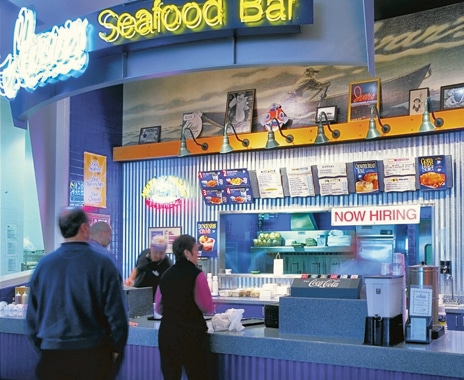
“This level of friendly service is critical to our brand,” Wlaschin says.
Using insights from regular customer satisfaction surveys and its purchasing power, Ivar’s recently widened its culinary profile with a rotating fresh catch promotion and an expanded grilled-fish program. Ivar’s also unveiled a more contemporary store format featuring mixed seating options and wood beams alongside a replica of the original Ivar’s neon sign.
“We work hard to understand the delicate balance between relevancy and history,” Wlaschin says.
While the chain remains open to expanding beyond its Washington base, Wlaschin says, that will only happen if the move is right. “We won’t look at a location where we can’t be true to who we are,” she says.
Skyline Chili
Cincinnati
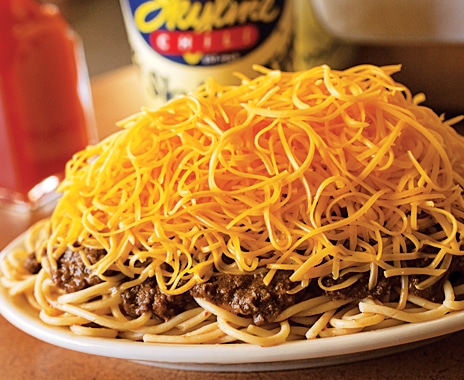 Asking about “the Ways” virtually anywhere outside of the greater Cincinnati, Ohio, area will likely earn someone a quizzical look. Posing the same question within Cincinnati’s borders, however, will point that person in the direction of Skyline Chili, the Queen City’s celebrated quick-service concept and the brand credited with creating Cincinnati-style chili.
Asking about “the Ways” virtually anywhere outside of the greater Cincinnati, Ohio, area will likely earn someone a quizzical look. Posing the same question within Cincinnati’s borders, however, will point that person in the direction of Skyline Chili, the Queen City’s celebrated quick-service concept and the brand credited with creating Cincinnati-style chili.
Since 1949, the Ways, a nod to Skyline’s signature chili dish and a customer’s desired toppings—shredded Cheddar, diced onions, and beans—has been engrained in Cincinnati vernacular and propelled Skyline’s position as a treasured local favorite.
“For over 60 years, we’ve been delivering a consistent product quickly, which has created an embedded customer base that’s loyal to us,” says Sarah Sicking, Skyline’s director of marketing.
Though Skyline has 131 units spread across four states, 95 of which are franchised stores, its unquestionable home base is Cincinnati. The Cincinnati metro area, population 2.1 million, is home to 84 Skyline restaurants, or about one location for every 25,000 residents.
In addition to the chain’s secret chili recipe, Skyline is also well known for its Cheese Coney, a proprietary Skyline hot dog covered in mustard, chili, diced onions, and shredded Cheddar. Though Skyline expanded its menu through the years and added items such as burritos, wraps, salads, and steamed potatoes, Skyline executive vice president Terry Donovan says, the restaurant’s primary path to relevancy remains the consistent delivery of its two core products: slow-cooked chili and the Cheese Coney.
“We’re going to stay on our toes and move with the consumer, but [menu changes] are not what we lead with,” Donovan says.
From 1986 until 2005, Skyline moved into new territory, including Michigan, Pennsylvania, and South Carolina, first as a public company and then under the hands of a private equity firm. Those units have since closed.
“Burger places might be able to more easily skip geography, but it’s a tougher sell with chili, which is much more regional,” Sicking says.
Since returning to private ownership in 2005, however, Skyline has embraced its local heritage and adopted a contiguous geography expansion plan, targeting two other Ohio cities, Dayton and Columbus, as its next market opportunities.
The Varsity
Atlanta
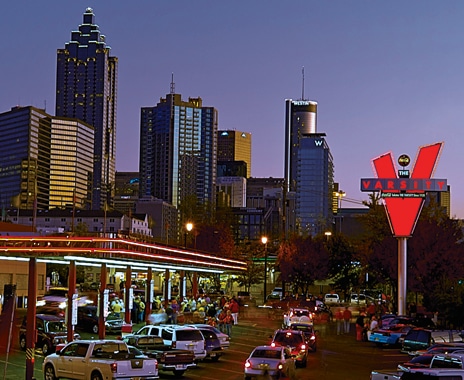 A downtown Atlanta landmark, the Varsity’s art deco building and curbside service attract millions of visitors throughout the year, ranging from politicos and priests to police and pilots.
A downtown Atlanta landmark, the Varsity’s art deco building and curbside service attract millions of visitors throughout the year, ranging from politicos and priests to police and pilots.
“We’re a real melting pot,” says Gordon Muir, president of the Varsity. On a football Saturday at nearby Georgia Tech, the Atlanta institution serves upward of 15,000 chili dogs, 300 gallons of chili, and 3,000 homemade pies from its flagship location.
With little more than $2,000, Frank Gordy founded the Varsity—originally called the Yellow Jacket in honor of Georgia Tech’s mascot—in 1928 in the back of a gas station. The eatery’s chili and hot dogs were an immediate hit, compelling Gordy to purchase an entire city block and construct an 800-seat restaurant on the five-acre site.
“In the Great Depression, that was a real big vision,” says Muir, Gordy’s grandson.
The Varsity now has six stores in and around Atlanta, as well as two units in Atlanta’s Hartsfield-Jackson Airport. Though Muir acknowledges it’s “nearly impossible” for the Varsity to replicate its historic downtown location in other settings, the consistency of the company’s menu and service from location to location—right down to the restaurant’s famous “What’ll ya have?” ordering prompt—allows each Varsity unit to retain tradition while notching its own sense of place.
Muir says the Varsity has also maintained its loyal customer following by doing the same things year after year: making its chili, pie dough, and chicken salad daily; using fresh produce; and serving up its famous frosted orange drink and hand-dipped onion rings like no one else can.
“The Varsity is something that doesn’t change in peoples’ lives,” Muir says. “If you keep your quality and treat people right, those are the standards that keep you going in any generation.”
With various properties in hand, the Varsity plans to slowly open new units in the coming years, including the launch of a new Atlanta-area location later this year.
“We’re just an old-fashioned family business, and we’re in no hurry to get bigger,” Muir says. “We’ll take our time and do things right.”

